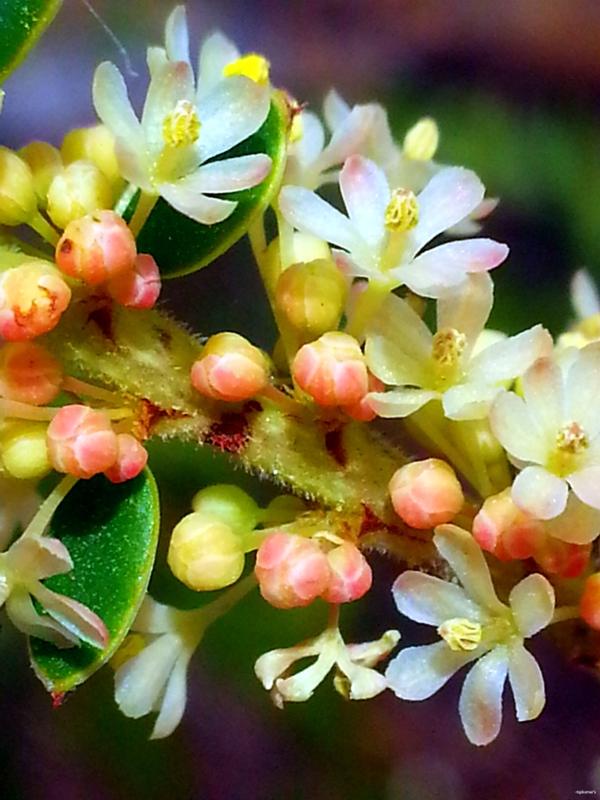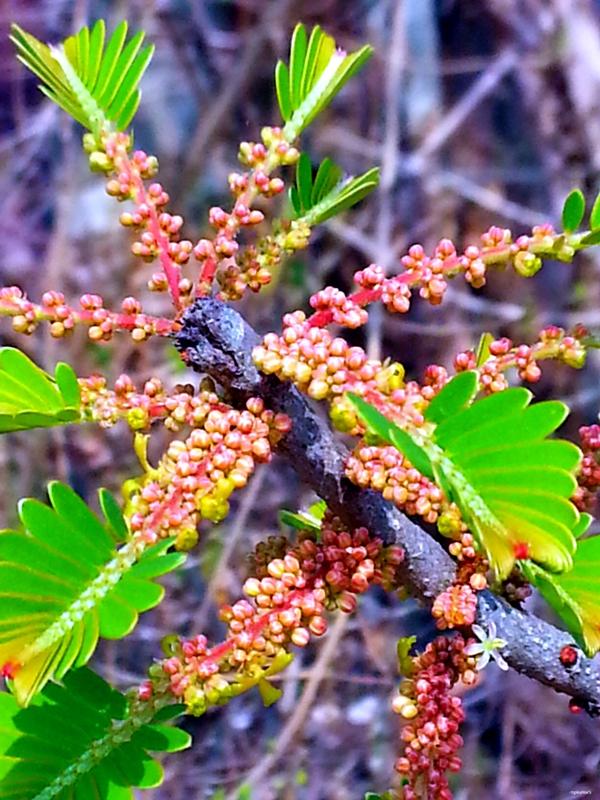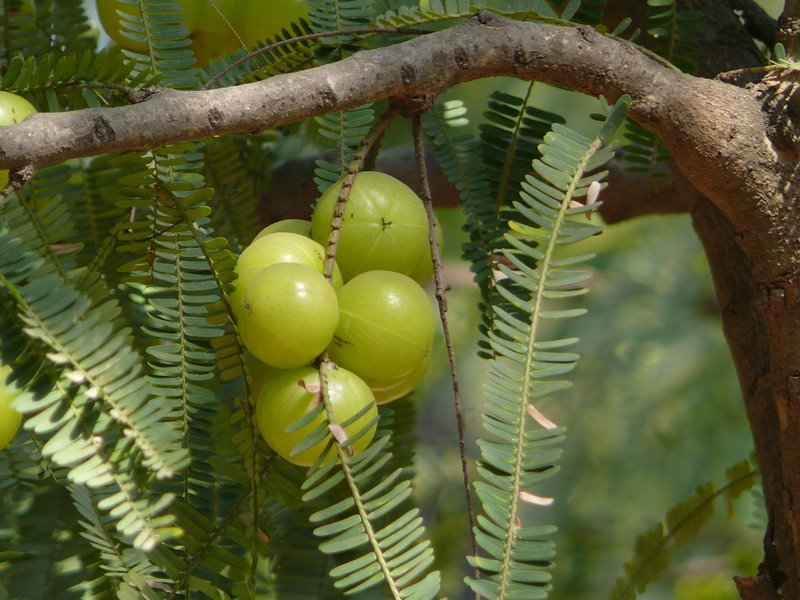
Emblica officinalis Gaertn.

Emblica officinalis Gaertn.

Emblica officinalis Gaertn.

Emblica officinalis Gaertn.
| Plant Category | : | Tree |
| Melghat's Flora's Serial No. | : | 459 |
| Synonym | : | Phyllanthus emblica L.;
Cicca emblica (L.) Kurz.;
Diasperus emblica (L.) Kuntze;.
Dichelactina nodicaulis Hance.;
Emblica arborea Raf.;
Phyllanthus glomeratus Roxb. ex Benth., nom. nud.;
Phyllanthus mairei H.Lév.;
Phyllanthus mimosifolius Salisb.;
Phyllanthus taxifolius D.Don.; |
| Plant Common Name | : | Aola, Amla, Indian gooseberry Hindi: Aonla Manipuri: Amla Marathi: Amla Tamil: Nelli Malayalam: Nelli, Nellikka Telugu: Usiri, Usirikaya Kannada: Betta nelli, Amalaka Oriya: Aonla Gujarati: ambala Sanskrit: Dhatri, amalaka |
| Plant Family | : | Euphorbiaceae |
| Description | : | A monoecious glabrous or pubescent deciduous tree, up to 15-20 in. Bark grey, smooth. Wood red, hard. Intermediate shoots up to 20 cm long, solitary or fascicled, resembling pinnate leaves but usually floriferous towards the base, falling as a unit; short shoots not strongly developed. Cataphylls triangular. lanceolate, 2 mm long, acuminate, brownish-black. Foliage-leaves up to 80-150 per shoot, closely distiehous; petioles 0.5 mm long; leaf-blades linear-oblong, 0.5-1.6 x 0.1-0.3 cm., usually obtuse, sometimes acute or subacute, somewhat obliquely rounded to subcordate at the base, margin thickened and inrolled, firmly chartaceous, lateral nerves 4-9 pairs, sometimes indistinct, light green above, paler and somewhat greyish beneath. Stipules of the cataphylls triangular-ovate, 1.5 mm long, acuminate, brownish-black; those of the leaves lanceolate, 0.7 mm long, reddish-brown. Proximal nodes barren, leafless, next ?, then with ? & ? flowers, distally barren again but leafy. Male flowers: pedicels slender, 1-2 mm long; sepals 6, oblong-oblanceolate, 1.5-2 x 0.5-0.7 mm, obtuse or rounded, entire, yellowish-green with a pale hyaline margin; disc of 6 small clavate glands or 0; stamens 3, the filaments completely connate into a short terete column, anthers sessile, distinct, erect, oblong, apiculate, 0.8 mm long, the sacs parallel, longitudinally dehiscent. Female flowers subsessile; sepals thicker than the ? and somewhat denticulate, otherwise similar; disc urceolate, 1.5 mm high, completely enclosing the ovary, 6-ribbed, lacerate at the top; ovary ovoid, 3-celled, c. 1 mm diam., smooth; styles 3, stout, fleshy, c. 4 mm long, united at the base, bipartite, the segments flattened, spreading, sometimes bifid. Fruit. subglobose, c. 2.5 cm diam. when fresh, smooth, succulent, greenish or yellowish-white; endocarp massive, woody, 6-ridged, tardily dehiscent, c. 2 mm thick. Seeds somewhat unequal, trigonous or plano-convex, 4-6 x 2.5-3 x 2-3 mm, 3 smooth, dark chestnut-brown. Fl. Per.: March-May; Fr. Per.: September-November. |
| Plant Location in Melghat | : | In Marida, Makhala, Churni, Pastalai, Chipi |
| Medicinal Use / Activity | : | Anti-cancer(fruit): Bandopadhyaya et al., 2015; an expectorant, anti-pyretic, diuretic, antiDiarrheal and antiscorbutic; fruit is given in order to allay the effects of aging and to restore the organs. The juice of the fruit is also given in order to strengthen the pancreas of diabetics, as well as in the treatment of eye problems, joint pain, Diarrhea and dysentery. inflammation, cancer, osteoporosis, neurological disorders, hypertension together with lifestyle diseases, parasitic and other infectious disorders; |
| Plant's Phytochemicals | : | COMPOUNDS: Emblicanin A; Emblicanin B; kaempferol; ellagic acid; gallic acid; punicafolin; phyllanemblinin A; phyllanemblin; punigluconin; pedunculagin; ascorbic acid; ellagic acid; leucodelphinidin; putranjivain A; rutin; quercetin; Triacontanol; Triacontanoic acid; beta-amyrin; Betulonic acid; Daucosterol; Lupeol acetate; Betulinic acid; Ursolic acid; Oleanolic acid; ACTIVE COMPOUNDS (12): Lupeol; Quercetin; Rutin; Kaempferol; Delphinidin; Betulinic acid; Ursolic Acid; Oleanolic Acid; Betulin; Ascorbic acid; Ellagic acid; Gallic Acid; |
| Plant's Current Status | : | - |
| Plant's Cross Database Reference | : | 259142 |
| Reference | : | Dhore M. A. (1984) The flora of melghat tiger reserve
- http://www.flowersofindia.net/catalog/slides/Amla.html
- http://tropical.theferns.info/viewtropical.php?id=Phyllanthus+emblica
- https://indiabiodiversity.org/species/show/31625
- https://www.ncbi.nlm.nih.gov/pubmed/27320046
- http://www.efloras.org/florataxon.aspx?flora_id=5&taxon_id=200012600
- https://www.ncbi.nlm.nih.gov/pubmed/26415402 |
| Reference | : | ~ Chellaiah Muthu, Muniappan Ayyanar, Nagappan Raja and Savarimuthu Ignacimuthu; "Medicinal plants used by traditional healers in Kancheepuram District of Tamil Nadu, India"; Journal of Ethnobiology and Ethnomedicine (2006); 2(43): 1-10 PMID : ~ Santosh Kumar Singh, Jay Ram Patel, Prashant Kumar Dubey and Sonia Thakur; "A review on anti-asthmatic activity of traditional medicinal plants"; IJPSR (2014); 5(10): 4109-4116 PMID : ~ Chandra Prakash Kala; "Aboriginal uses and management of ethnobotanical species in deciduous forests of Chhattisgarh state in India"; Journal of Ethnobiology and Ethnomedicine (2009); 5(20): 1-9 PMID : ~ Kuldip S. Dogra, Sandeep Chauhan and Jeewan S. Jalal; "Assessment of Indian medicinal plants for the treatment of asthma"; Journal of Medicinal Plants Research (2015); 9(32): 851-862 PMID : ~ Dhore MA and Joshi PA; "Flora of Melghat Tiger Reserve"; Directorate, Project Tiger, Melghat (1988); PMID : ~ Sonika Jain, Jaya Dwivedi, Pankaj Kumar Jain, Swaha Satpathy and Arjun Patra; "Medicinal Plants for Treatment of Cancer: A Brief Review"; Pharmacogn. J. (2016); 8(2): 87-102 PMID : ~ Kavishankar, G.B; Lakshmidevi, N.; Murthy, S.M.; Prakash, H.S. and Niranjana, S.R.; "Diabetes and medicinal plants-A review"; Int J Pharm Biomed Sci (2011); 2(3): 65-80 PMID : |
| Kingdom | : Plantae - Plants |
|---|---|
| Phylum | : Tracheophyta |
| Subkingdom | : Tracheobionta - Vascular plants |
| Superdivision | : Spermatophyta - Seed plants |
| Division | : Magnoliophyta - Flowering plants |
| Class | : Magnoliopsida - Dicotyledons |
| Subclass | : Rosidae |
| Order | : Euphorbiales |
| Family | : Euphorbiaceae - Spurge family |
| Genus | : Emblica |
| Species | : Emblica officinalis Gaertn. |